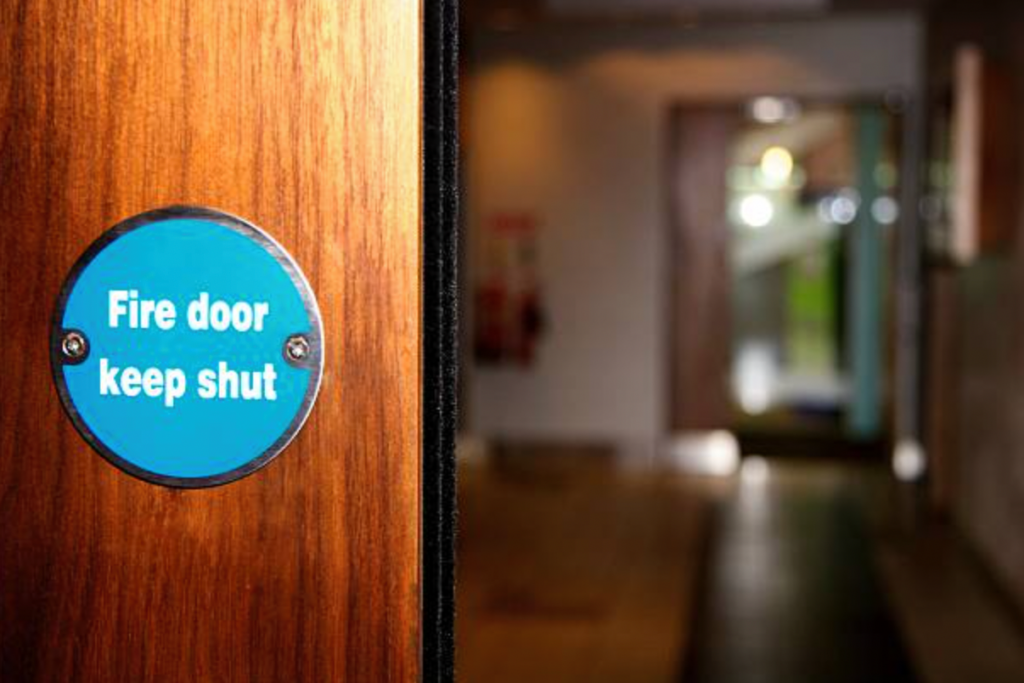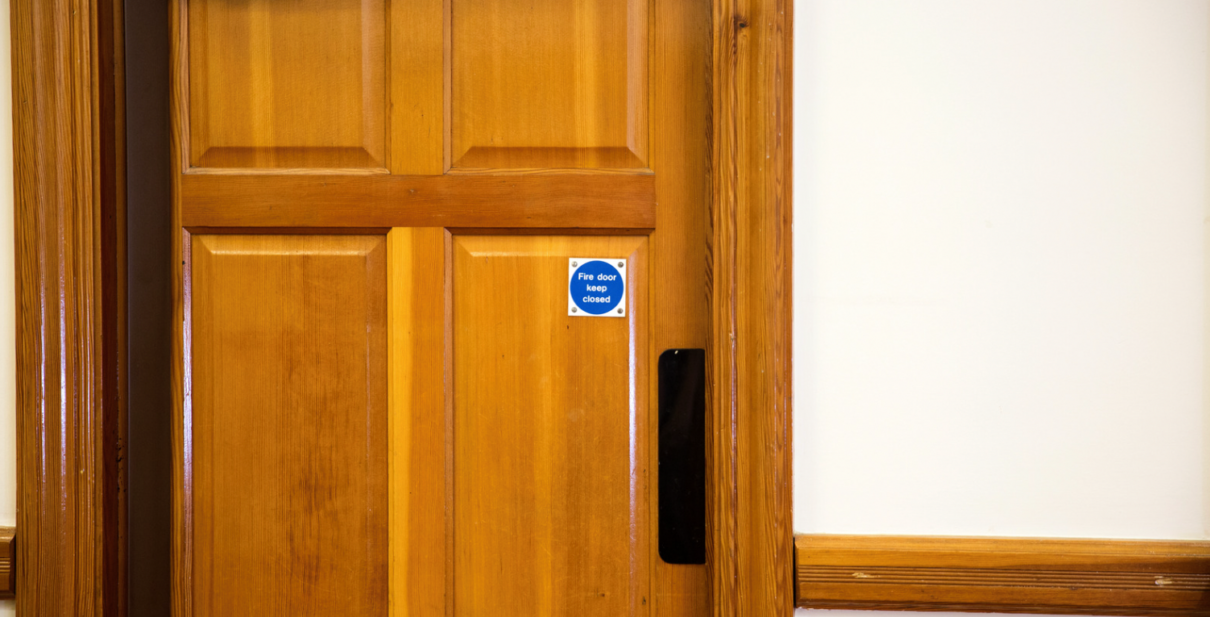If you’re wondering what a fire door is, then you’ve come to the right place. In this blog, we’ll give you a comprehensive introduction to fire doors and explain why they’re so important for any building.
What Is a Fire Door and What Are They Designed To Do?
A fire door is a type of door that has been designed to provide a barrier between two areas and prevent the spread of fire and smoke. Fire doors are typically made from some form of strong material with special seals around the edges, which help them resist the passage of smoke, flames, and hot gases.
These types of doors can be found in homes, commercial buildings and large public buildings like hospitals and schools and are required fire protection measures.
How Often Should Fire Doors Be Checked?
It is now a legal requirement to have annual fire door inspections of flat entrance doors and quarterly checks of communal doors in multi-occupied residential buildings above 11 meters. The regulations also require responsible persons to provide their residents of all multi-occupancy residential buildings with information on the importance of fire doors to a building’s fire safety.
Who Conducts Fire Door Checks?
Fire door checks should only be carried out by qualified and experienced fire safety professionals. This is to ensure that any potential hazards or defects are detected and rectified before they become a risk to the building’s occupants.
If you’re in need of a fire door check, or simply have some questions about fire door safety, please get in touch. Here at Global Facilities, we have a team of highly qualified professionals who can help you keep your building up to the latest fire safety standards. We believe that fire door safety should be taken seriously and with regular maintenance, it is possible to provide your building the highest level of protection against potential fires.
What Is Involved In a Fire Door Check?
A fire door check should always be carried out by a licensed professional, however, if you’re a landlord or property owner, there are several things that you can do to ensure your fire door is safe and compliant.
First of all, you should begin by checking that the door closes automatically. Begin by opening the door halfway and checking that it closes ‘to latch’. If it doesn’t, that is a sign that the door needs adjusting.
Next, ensure that the fire door seals are undamaged and correctly in place. These smoke seals expand with heat in the event of a fire to stop fire and smoke from coming through.
Other checks include:
Ensure that there is no damage to the door and that there aren’t any missing or broken screws.
Find the hinges and check that they are secure and in good condition.
Check the gaps between the door and the door frame. There should be less than 4mm at the top and sides and less than 8mm at the bottom.
Check the certification. When a fire door inspection is carried out, they will leave a sticker or badge showing the fire door’s rating.
Find out more about booking a fire door survey.

Where Are Fire Doors Required?
Fire doors are legally required in all non-domestic properties, such as businesses, commercial areas, and public buildings. This is because these types of buildings often have a higher risk of fire and must be properly protected from the dangers. Fire doors, such as in flats and multi-storey homes, are also required in domestic buildings above 11 meters.
Key Features Of Fire Doors
The three main features of fire doors are as follows:
• Fire Rated – All fire doors must be fire rated, meaning they must have been tested and certified to withstand a certain amount of heat and smoke.
• Self-Closing – Most fire doors are designed with an automatic closing mechanism that activates when a certain temperature is reached, or the door is opened.
• Seals – Fire doors should have special seals around the edges, which help to prevent smoke, flames and hot gases from passing through. Fire door assemblies will check that these seals are working properly to provide the proper fire resistance.
What Is The Maximum Gap Allowed Under a Fire Door?
The maximum gap allowed under a fire door is 8-10mm. This is to ensure that the door can properly close and seal when needed. Any gaps larger than this could put your property at risk of a fire spreading quickly and easily throughout the building. During fire door assembly, it is important to check the gaps, seals and closing mechanism.

What Are The Regulations Surrounding Fire Doors?
This year, a new regulation has been published under Article 24 of the Regulatory Reform (Fire Safety) Order 2005 –The Fire Safety (England) Regulations 2022. This meant that it is now a legal requirement to have annual inspections of flat entrance doors and quarterly checks of communal doors in multi-occupied residential buildings above 11 meters.
By making it a legal requirement for fire doors to be checked, it will reduce the chance of fire door failure. This is because regular inspections mean that minor defects can be identified and rectified before becoming a bigger problem. It also means that fire doors are correctly installed and maintained, which is essential for keeping everyone in the building safe.
Find out more about fire door regulations.
What Are The Benefits of Fire Doors?
Let’s explore the numerous benefits that fire doors can provide to your home or business:
Increased Safety
Fire doors are designed to keep occupants safe by preventing the spread of flames and smoke, giving them more time to escape in case of an emergency.
Reduced Damage
Fire doors also help to minimize damage caused by a fire. They reduce the amount of heat and smoke that can enter a room, preventing the fire from spreading quickly.
Improved Security
Fire doors also have an added security advantage over regular doors. The strong construction of the door and its self-closing mechanism make it harder for intruders to gain access to your home or business.
Lower Insurance Costs
By having a fire door in place, you can reduce your insurance premiums as the risk of damage is decreased.
Conclusion
We hope that this blog has been helpful in explaining the importance of fire doors and the regulations surrounding them. Fire doors are an essential feature in any building, as they provide increased safety and security for occupants. Installing a fire door is not only important legally but can also save you time and money in the long run by reducing damage caused by fires and lowering your insurance premiums. With proper maintenance and regular inspections, fire doors can provide peace of mind that your family or business is safe and secure. If you have any questions about fire door regulations or installation, please contact a professional for advice. Remember, safety comes first!
Fire Door FAQs:
We've done our best to try and answer some of the most frequently asked questions about fire doors below:
The difference between these types of doors is that a fire door is designed to prevent the spread of fire throughout a building, whereas a normal door is not. A fire door has a fire rating and seal to trap smoke and fire in one room and is self-closing.
Yes, contrary to popular belief, wooden doors can be used as fire doors. This is because they are often filled with a resistant filler material such as gypsum. When installing fire doors, it is best to seek professional advice from fire door manufacturers or installers.
Yes, however, it must be made from a specialist fire-resistant glass such as ceramic or borosilicate.




